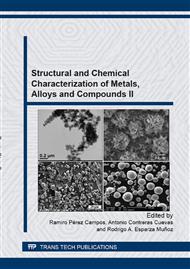[1]
C.D. Yang, W. Li, and W. Zhi, Study on mechanical behavior and electronic structures of Al–Cu intermetallic compounds based on first-principles calculations, Solid State Communications 151 (2011) 1270-1274
DOI: 10.1016/j.ssc.2011.05.040
Google Scholar
[2]
C. Patiño-Carachure, E. García-De León, C. Angeles-Chávez, R. Esparza and G. Rosas-Trejo, Hydrogen embrittlement assisted by ball-milling to obtain AlCuFe nanoparticles, Journal of Non-Crystalline Solids 355 (2009) 1713-1718.
DOI: 10.1016/j.jnoncrysol.2009.06.019
Google Scholar
[3]
C.T. Liu, Recent advances in ordered intermetallics, Materials Chemistry and Physics 42 (1995) 77-86.
Google Scholar
[4]
M. R. Louthan Jr, Hydrogen Embrittlement of Metals: A Primer for the failure analyst, Journal of Failure Analysis and Prevention 8 (2008) 289-307.
DOI: 10.1007/s11668-008-9133-x
Google Scholar
[5]
E. Pouillier, A.-F. Gourgues, D. Tanguy, E.P. Busso, A study of intergranular fracture in an aluminium alloy due to hydrogen embrittlement, International Journal of Plasticity 34 (2012) 139-153.
DOI: 10.1016/j.ijplas.2012.01.004
Google Scholar
[6]
S. Semboshi, N. Masahashi, S. Hanada, Hydrogen pulverization of refractory metals, alloys and intermetallics, Metals and Materials International 10 (2004) 45-53.
DOI: 10.1007/bf03027363
Google Scholar
[7]
H. Nie, S. Zhang, M. Schoenitz E. L. Dreizin, Reaction interface between aluminum and water, International Journal of Hydrogen Energy 38 (2013) 11222-11232.
DOI: 10.1016/j.ijhydene.2013.06.097
Google Scholar
[8]
J. T. Ziebarth, J. M. Woodall, R. A. Kramer, G. Choi, Liquid phase-enabled reaction of Al-Ga and Al-Ga-In-Sn alloys with water, International Journal of Hydrogen Energy 36 (2011) 5271-5279.
DOI: 10.1016/j.ijhydene.2011.01.127
Google Scholar
[9]
H. Wang, Y. Chang, S. Dong, Z. Lei, Q. Zhu, P. Luo, Z. Xie, Investigation on hydrogen production using multicomponent aluminum alloys at mild conditions and its mechanism, International Journal of Hydrogen Energy 38 (2013) 1236-1243.
DOI: 10.1016/j.ijhydene.2012.11.034
Google Scholar
[10]
J. Skrovan, A. Alfantazi, T. Troczynski, Hydrogen generation by accelerating aluminum corrosion in water with alumina, World Academy of Science, Engineering and Technology 79 (2011) 325-330.
Google Scholar
[11]
X. Chen, Z. Zhao, M. Hao, D. Wang, Research of hydrogen generation by the reaction of Al-based materials with water, Journal of Power Sources 222 (2013) 188-195.
DOI: 10.1016/j.jpowsour.2012.08.078
Google Scholar
[12]
M. Pudukudy, Z. Yaakob, B. Narayanan, R. Ramakrishnan, S. Viswanathan, Hydrogen production from sea water using waste aluminium and calcium oxide, International Journal of Hydrogen Energy 37 (2012) 7451-7456.
DOI: 10.1016/j.ijhydene.2012.01.106
Google Scholar
[13]
S. Liu, M. Fan, C. Wang, Y. Huang, D. Chen, L. Bai, K. Shu, Hydrogen generation by hydrolysis of Al-Li-Bi-NaCl mixture with pure water, International Journal of Hydrogen Energy 37 (2012) 1014-1020.
DOI: 10.1016/j.ijhydene.2011.03.029
Google Scholar
[14]
S.S. Razavi-Tousi, G.A. Nematollahi, T. Ebadzadeh, J.A. Szpunar, Modifying aluminum- water reaction to generate nano-sized aluminum hydroxide particles beside hydrogen, Powder Technology 241 (2013) 166-173.
DOI: 10.1016/j.powtec.2013.03.025
Google Scholar
[15]
H.T. Teng, T.Y. Lee, Y.K. Chen, H.W. Wang, G. Cao, Effect of Al(OH)3 on the hydrogen generation of aluminum-water system, Journal of Power Sources 219 (2012) 16-21.
DOI: 10.1016/j.jpowsour.2012.06.077
Google Scholar
[16]
S.S. Razavi-Tousi, J.A. Szpunar, Effect of structural evolution of aluminum powder during ball milling on hydrogen generation in aluminum-water reaction, International Journal of Hydrogen Energy 38 (2013) 795-806.
DOI: 10.1016/j.ijhydene.2012.10.106
Google Scholar
[17]
E. Garcia de León, O. Téllez-Vázquez, C. Patiño-Carachure, G. Rosas, DSC-TGA hydrogen evaluation during mechanical milling of AlFe intermetallic, Materials Science Forum 755 (2013) 105-110.
DOI: 10.4028/www.scientific.net/msf.755.105
Google Scholar
[18]
J.L. López-Miranda, J.R. Romero, R. Esparza, G. Rosas, Structural evolution of FeAl3 intermetallic during high energy ball-milling, Materials Science Forum 755 (2013) 133-138.
DOI: 10.4028/www.scientific.net/msf.755.133
Google Scholar


